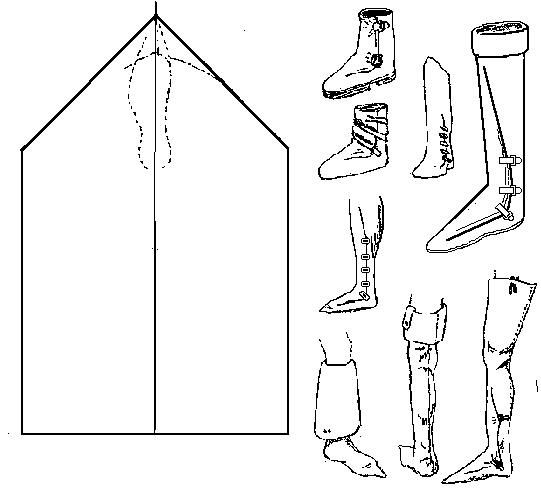Difference between revisions of "Footwear"
From AmtWiki
(New page: ===Links=== *[http://www.personal.utulsa.edu/~marc-carlson/shoe/SHOEHOME.HTM How to make] footwear by Marc Carlson Category:Garb Category:Amtgard Things) |
|||
| Line 1: | Line 1: | ||
| + | [[Image:SHOE27.GIF|thumb|According to the Dictionary of Costume, this style of footwear, called the Gamashe in the 17th century, is the ancestor of the military legging of later centuries. Such linen leggings are distinguishing marks of peasants and farmers for centuries. In any case, I have no evidence that it appears any earlier than the 14th century. It is a lined turned shoe, made with a rand or a full welt. The method of securing the boot appears to vary, from straps and buckles, to lacing a stretch from 10 to 12 inches along the side of the leg, even all the way up from the ankle to the knee.]] | ||
| + | |||
===Links=== | ===Links=== | ||
*[http://www.personal.utulsa.edu/~marc-carlson/shoe/SHOEHOME.HTM How to make] footwear by Marc Carlson | *[http://www.personal.utulsa.edu/~marc-carlson/shoe/SHOEHOME.HTM How to make] footwear by Marc Carlson | ||
[[Category:Garb]] [[Category:Amtgard Things]] | [[Category:Garb]] [[Category:Amtgard Things]] | ||
Revision as of 21:13, 4 November 2008

According to the Dictionary of Costume, this style of footwear, called the Gamashe in the 17th century, is the ancestor of the military legging of later centuries. Such linen leggings are distinguishing marks of peasants and farmers for centuries. In any case, I have no evidence that it appears any earlier than the 14th century. It is a lined turned shoe, made with a rand or a full welt. The method of securing the boot appears to vary, from straps and buckles, to lacing a stretch from 10 to 12 inches along the side of the leg, even all the way up from the ankle to the knee.
Links
- How to make footwear by Marc Carlson